Monday, January 31, 2011
SCBWI-National Conference
If you didn't make it to the SCBWI Conference, check out their blog where you'll find excerpts of the event.
Saturday, January 29, 2011
More Notes from the Conference
Here are links to notes from some of the WD/NYC sessions I was unable to attend:
Ask the Agent - Panel: Janet Reid, Donald Maass, Jud Laghi, Mary Kole.
10 Essential Things You Must Know to Craft an Effective Query - Janet Reid
Putting Fire in Your Fiction - Donald Maass
Building the Perfect Plot - James Scott Bell
Your Publishing Options - Jane Friedman
Successfully Promoting Your Book -
Ask the Agent - Panel: Janet Reid, Donald Maass, Jud Laghi, Mary Kole.
10 Essential Things You Must Know to Craft an Effective Query - Janet Reid
Putting Fire in Your Fiction - Donald Maass
Building the Perfect Plot - James Scott Bell
Your Publishing Options - Jane Friedman
Successfully Promoting Your Book -
Friday, January 28, 2011
After the Conference
That brings this blog up to date on the Conference. Overall, I found it informative and worthwhile. I wish they would have offered tapes of the sessions so that I could hear the ones I missed. It was hard to pick from the variety they had available.
Would I do it again? Not in the winter! The rest of my week has been really wild. On Monday, I rested up. On Tuesday, I did a research trip to Philadelphis and visited Independence Hall, the Liberty Bell, Ben Franklin's original home, Betsy Ross House (it was closed), the Mint, and the Tomb of the Unknown Soldiers. Independence Hall was fabulous!
I got to eat a genuine Philly Cheesesteak at the Philadelphia Bourse and even got a peanut butter Tasty Cake - all my favorite East Coast foods!
Wednesday, I was supposed to fly home, but my flight got cancelled because of snow - 16" in Philly! I tried to get out on Thursday, but only got to St. Louis. Had to spend the night at a hotel. Today, Friday, I'm trying to make my way back to Tulsa. Right now, I'm waiting for breakfast; then it's back to the airport. Got my fingers crossed!
Would I do it again? Not in the winter! The rest of my week has been really wild. On Monday, I rested up. On Tuesday, I did a research trip to Philadelphis and visited Independence Hall, the Liberty Bell, Ben Franklin's original home, Betsy Ross House (it was closed), the Mint, and the Tomb of the Unknown Soldiers. Independence Hall was fabulous!
I got to eat a genuine Philly Cheesesteak at the Philadelphia Bourse and even got a peanut butter Tasty Cake - all my favorite East Coast foods!
Wednesday, I was supposed to fly home, but my flight got cancelled because of snow - 16" in Philly! I tried to get out on Thursday, but only got to St. Louis. Had to spend the night at a hotel. Today, Friday, I'm trying to make my way back to Tulsa. Right now, I'm waiting for breakfast; then it's back to the airport. Got my fingers crossed!
Day 5: Session 3
The last session I attended was Success Strategies and Sytems for Writing & Selling More by Sage Cohen. This session came directly from her book, The Productive Writer.
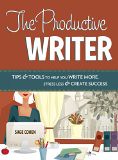
If you're looking for some time management tips directed at writers, check it out.

If you're looking for some time management tips directed at writers, check it out.
Day 5: Sunday Session 2
This was one of my favorite sessions: Revision: Learn How to Love it by James Scott Bell. In this session, Bell explained his step-by-step method for editing a manuscript.
First: Write hot and revise cool. The only revision Bell does on his first draft is to edit his previous day's work for stylistic changes, fix things that don't make sense, and do a spell check. Then Bell goes right into today's work. As Bell said, "Don't get into big issues."
Bell likes to make a Rolling outline. He writes a scene, then outlines the next 2-3 chapters. He says it's "like driving ahead with headlights on!" You only look at what's right in front of you.
After your first draft is written, Bell recommends that you put it away for at least two weeks, a month is even better. He wants you to "come back as a reader picking it up for the first time." He even suggested making it into a book written by someone else. Print out a hard copy; create a cover with someone else's name on it and a blurb about the book. Then sit down and read it as a reader brand new to the book.
Read through with minimal notes the first time. Bell recommended four markings for this first read through:
1. Check mark for where story is dragging. So I can a come back and ask why this is dragging.
2. Parenthesis around sentences that don't work - clunky metaphors (He was as tall as a tree)
3. Circle in margin for material that needs to be added. An emotion that's not there or other putter inner
4. Question Mark - when I'm totally confused. Why did I write that?
Bell then shared a variety of exercises (too many to list) on how to look for problems in character, plot, scenes, etc.
After you finish the first read through, Bell advised that you write a new summary (2,000 words) of your novel. But not exactly as you wrote the first draft. "The summary should be tight and compelling, like a back cover on steroids." Write this summary 3 - 6 times. When you are finished, this will be the basis of your second draft without having to write a whole 2nd draft!
Another technique Bell suggested was: After the first draft, try throwing out the 1st chapter and then start with Chapter 2.
He spent some time on dialogue and how to improve it, but it's too much to go into here.
After the second draft and edits, repeat the process until it's ready for submission.
Look at:
1. Scene Openings - do it in different ways - immediately in the midst of action or start with the dialogue and set the scene
2. Look at Chapter endings - end with forward momentum
3. Look through dialogue and compress as much as possible (If you can, put a dialogue at beginning (editors want this).

If you want to know more, I highly recommend getting Bell's book! This was a 5+ star workshop!
First: Write hot and revise cool. The only revision Bell does on his first draft is to edit his previous day's work for stylistic changes, fix things that don't make sense, and do a spell check. Then Bell goes right into today's work. As Bell said, "Don't get into big issues."
Bell likes to make a Rolling outline. He writes a scene, then outlines the next 2-3 chapters. He says it's "like driving ahead with headlights on!" You only look at what's right in front of you.
After your first draft is written, Bell recommends that you put it away for at least two weeks, a month is even better. He wants you to "come back as a reader picking it up for the first time." He even suggested making it into a book written by someone else. Print out a hard copy; create a cover with someone else's name on it and a blurb about the book. Then sit down and read it as a reader brand new to the book.
Read through with minimal notes the first time. Bell recommended four markings for this first read through:
1. Check mark for where story is dragging. So I can a come back and ask why this is dragging.
2. Parenthesis around sentences that don't work - clunky metaphors (He was as tall as a tree)
3. Circle in margin for material that needs to be added. An emotion that's not there or other putter inner
4. Question Mark - when I'm totally confused. Why did I write that?
Bell then shared a variety of exercises (too many to list) on how to look for problems in character, plot, scenes, etc.
After you finish the first read through, Bell advised that you write a new summary (2,000 words) of your novel. But not exactly as you wrote the first draft. "The summary should be tight and compelling, like a back cover on steroids." Write this summary 3 - 6 times. When you are finished, this will be the basis of your second draft without having to write a whole 2nd draft!
Another technique Bell suggested was: After the first draft, try throwing out the 1st chapter and then start with Chapter 2.
He spent some time on dialogue and how to improve it, but it's too much to go into here.
After the second draft and edits, repeat the process until it's ready for submission.
Look at:
1. Scene Openings - do it in different ways - immediately in the midst of action or start with the dialogue and set the scene
2. Look at Chapter endings - end with forward momentum
3. Look through dialogue and compress as much as possible (If you can, put a dialogue at beginning (editors want this).

If you want to know more, I highly recommend getting Bell's book! This was a 5+ star workshop!
Thursday, January 27, 2011
Day 5: Sunday, Session 1
On Sunday, my brother, Keith, and his wife, June, met us in the hotel for breakfast. They were leaving from New York on a cruise later in the day. Breakfast was fabulous! If you ever go to New York, I highly recommend the Sheraton New York on 7th street.

Breakfast!
That morning I went to three more sessions. The first was Writers and Mobile Apps: The Big Opportunity by Al Katkowsky.
As an iPhone/iPad app reviewer and an author, I was extremely interested in this topic. Katowsky talked about why we should consider building a book app: money and exposure; what books are best for an app (any that lend itself to multimedia or tech books - example is iPhone Missing Manual); and what he used to build his app.
Most of his session was way too complicated for me to write here. Basically, he suggested finding a good app developer unless you feel competent to do it yourself and be prepared for your launch by have preselected downloaders (people who will download your app the first day). This is to ensure that your app will get noticed.
As an app reviewer, I would like to add that getting your app reviewed by a major magazine (such as iPhone Life) is a good way to get publicity. Also, create a press release. Reviewers get these to find apps they want to review. (Keep your PR simple! Personally, I hate long PRs. Keep it short and to the point; give me links to photos and videos.)
I'd also like to add that picture books and YA novels can be successfully done on an app. But don't merely put text, static images, and some music in your app and think it will sell. Personally, I'd rather read the actual picture book, itself, than read that. But if you can create one like these: Jack in the Beanstalk by Ayars Animation, Icarus Swinebucket by Michael Garland (created by Giant Atom), and Bram Stoker's Dracula (the Vook version), you'll have a winner!
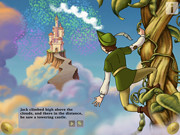

Breakfast!
That morning I went to three more sessions. The first was Writers and Mobile Apps: The Big Opportunity by Al Katkowsky.
As an iPhone/iPad app reviewer and an author, I was extremely interested in this topic. Katowsky talked about why we should consider building a book app: money and exposure; what books are best for an app (any that lend itself to multimedia or tech books - example is iPhone Missing Manual); and what he used to build his app.
Most of his session was way too complicated for me to write here. Basically, he suggested finding a good app developer unless you feel competent to do it yourself and be prepared for your launch by have preselected downloaders (people who will download your app the first day). This is to ensure that your app will get noticed.
As an app reviewer, I would like to add that getting your app reviewed by a major magazine (such as iPhone Life) is a good way to get publicity. Also, create a press release. Reviewers get these to find apps they want to review. (Keep your PR simple! Personally, I hate long PRs. Keep it short and to the point; give me links to photos and videos.)
I'd also like to add that picture books and YA novels can be successfully done on an app. But don't merely put text, static images, and some music in your app and think it will sell. Personally, I'd rather read the actual picture book, itself, than read that. But if you can create one like these: Jack in the Beanstalk by Ayars Animation, Icarus Swinebucket by Michael Garland (created by Giant Atom), and Bram Stoker's Dracula (the Vook version), you'll have a winner!

Labels:
Books,
Publishing,
Technology,
Writer's Conference
Day 4: Sat. Night in NYC
After my sessions, Debbie and I took off for dinner and more sight-seeing around NYC. (Debbie had already been walking all day, for which I was glad. She was in better shape than I, and I could barely keep up with her as it was!)
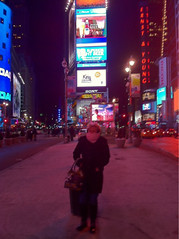
Me freezing in Times Square
We visited the ToysRUs store next to times square and had fun riding the gigantic 4-story ferris wheel inside!
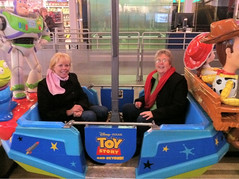
Toys R Us: Wheel
There was also an enormous Barbie Doll House and this Dino that I just loved! He roared, moved and everything!

Toys R Us: Dino
Next, we visited St.Patrick's Cathedral. What a beautiful church!

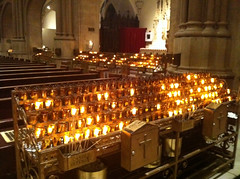
We ended the night at a great seafood restaurant nearby (can't remember the name), but I had lobster!
Next
It was so cold, that was about all we could take for the night.

Me freezing in Times Square
We visited the ToysRUs store next to times square and had fun riding the gigantic 4-story ferris wheel inside!

Toys R Us: Wheel
There was also an enormous Barbie Doll House and this Dino that I just loved! He roared, moved and everything!

Toys R Us: Dino
Next, we visited St.Patrick's Cathedral. What a beautiful church!


We ended the night at a great seafood restaurant nearby (can't remember the name), but I had lobster!
Next
It was so cold, that was about all we could take for the night.
Day 4: Sat. Session 4 and 5
Session 4: E-Publishing & Multimedia Options, Effective Strategies for Producing Yourself Online and Growing Readership with a panel made up of: David Carnoy, Andrew Schaffer, April Hamilton, and Jane Friedman
This was another panel discussion focusing on the tools of self publishing. Most of this was covered in the previous session. A few details were added, but again it was based on opinion and experience of each author.
Session 5 was the Pitch Slam, which I described in a previous post.
This was another panel discussion focusing on the tools of self publishing. Most of this was covered in the previous session. A few details were added, but again it was based on opinion and experience of each author.
Session 5 was the Pitch Slam, which I described in a previous post.
Day 4: Sat, Session 3
Keynote: How to Be an Author in a World Where Everyone is a Writer by Richard Nash.
Nash gave us a brief history of the publishing industry, starting with before Gutenberg and ending with today. After the printing press was invented, people began to write for self expression, rather than as a task. But writing was still limited to a few. After Pagemaker was created, anyone could write. As Nash said, "Far more people can now tell their story. The supply problem has been solve. We have not solved the demand side of the equation. How do we find the readers for the supply of writing?" There's been a 40 fold increase in the supply of books just in the last 20 years.
Then Nash talked about our "curve as a writer." One person may be willing to pay $10 to engage with you; another $5.00; another only $ .99.
I didn't quite follow his answer to "So how am I to be an author who is read?" related to this "curve." But he continued, "By reading in a world where everyone is an author. Participate in your culture. Engage in the society you want to speak back to." Read books, blogs, etc.
My takeaway on this was that we need to be engaged where our readers are, whether it is online or in person. We now have the tools to write, but only those who are engaged are going to successful in this world where there is more supply of writers than demand.
Nash gave us a brief history of the publishing industry, starting with before Gutenberg and ending with today. After the printing press was invented, people began to write for self expression, rather than as a task. But writing was still limited to a few. After Pagemaker was created, anyone could write. As Nash said, "Far more people can now tell their story. The supply problem has been solve. We have not solved the demand side of the equation. How do we find the readers for the supply of writing?" There's been a 40 fold increase in the supply of books just in the last 20 years.
Then Nash talked about our "curve as a writer." One person may be willing to pay $10 to engage with you; another $5.00; another only $ .99.
I didn't quite follow his answer to "So how am I to be an author who is read?" related to this "curve." But he continued, "By reading in a world where everyone is an author. Participate in your culture. Engage in the society you want to speak back to." Read books, blogs, etc.
My takeaway on this was that we need to be engaged where our readers are, whether it is online or in person. We now have the tools to write, but only those who are engaged are going to successful in this world where there is more supply of writers than demand.
Wednesday, January 26, 2011
Day 4, Sat. Session 2
Do-it-Yourself Publishing and How to be Successful at It. This was a panel discussion with Jane Friedman, Patricia Davis, Moriah Jovan, David Carnoy, and April Hamilton.
Because this was a panel discussion, there were a variety of opinions on the topic. Too many to list here. As with all of us, they all had different ways of working, depending on their goals. The bottom line on this is that you need to have a goal for your writing: Do you want to be published traditionally? Are you more of an entrepreneur and rather do it yourself? Do you want to take time to learn how to publish your own books?
Some of the resources they covered were Create Space on Amazon, Lighting Source, Smashwords and Fast Pencil. They discussed pricing and mostly agreed that the sweet spot for e-books was $3.99 for fiction. Nonfiction has much more fluctuations and depended on supply and demand.
As a self-publisher, you can get your books into audio using PodioBooks.com.
You can get your books into libraries and bookstores by going through Lightning Source and Create Space.
If you're doing color books, they recommended creating an app rather than an e-book.
Because this was a panel discussion, there were a variety of opinions on the topic. Too many to list here. As with all of us, they all had different ways of working, depending on their goals. The bottom line on this is that you need to have a goal for your writing: Do you want to be published traditionally? Are you more of an entrepreneur and rather do it yourself? Do you want to take time to learn how to publish your own books?
Some of the resources they covered were Create Space on Amazon, Lighting Source, Smashwords and Fast Pencil. They discussed pricing and mostly agreed that the sweet spot for e-books was $3.99 for fiction. Nonfiction has much more fluctuations and depended on supply and demand.
As a self-publisher, you can get your books into audio using PodioBooks.com.
You can get your books into libraries and bookstores by going through Lightning Source and Create Space.
If you're doing color books, they recommended creating an app rather than an e-book.
Labels:
E-Books,
Independent Publishing,
Writer's Conference
The Journal of Universal Rejection
I got this in my e-mail this morning from OWFI and thought some of you might enjoy it. The Journal of Universal Rejection.
Tuesday, January 25, 2011
Day 4: Sat. Session 1
The first session I attended on Saturday was Marketing Yourself in the Digital Age-Guy LeCharles Gonzales (Digital Bookworld)
Gonzales first discussed "whose responsibility is marketing?" He says, "It's everybodies." Both the publisher and the author have a responsibility to get the word out. "Marketing is everything a company does to acquire customers and maintain a relationship with them."
For writers, that means having a platform. "A platform is the way you engage with your audience. You need to build communities that enable your audience to comment on news, create news, and share the news with others."
Community is voluntary. "People do not remain in communities that no longer meet their emotional or intellectual needs." Cluetrain Manifesto (book - read it).
Writers should not start something they can't maintain. Gonzales said that you "must be ready to deal with the responses you get." You don't need to be everywhere (Facebook, twitter, Blog, Dig, etc). Just pick those that are relevant.
And don't wait to get started. Gonzales said "the best time to start promoting your book is three years before it comes out."
Some Online places Gonzales recommended that authors participate:
Blog, Twitter, Goodreads, Amazon Author Central and Linked In for nonfiction writers.
Someone in the audience asked about writing for others such as Huffington Post. His opinion is that "if you're going to give your writing away, why not do it on your own platform? You're only giving them emails and connections!"
What should you blog about? Gonzales says it depends on what you are about. Nonfiction - blog about your area of expertise. Think about TV extras. What adds to your book?
Fiction - Give writing advice based on your experience, but you need a really interesting angle (writing advice is everywhere); talk about yourself and things that interest you; a children's book author can blog about topics for kids (keep it kid-friendly), review like-topic books and books you care about.
Followers - don't get caught up in numbers - it's about relevance. Find the people who are relevant to you, your book, your expertise
He also says to blog on YOUR NAME blog. Get your name out there.
Gonzales had an interesting take on Facebook. According to him, statistics show that the biggest adopters of FB is those age 55 and above. He doesn't do Facebook because as he said, "most will be dead in 5 years!" I'm not sure how I like that statement as a 60+ person myself, but I suppose he has a point if you're trying to reach the younger audience and if his statistics are true. He said that Twitter was the biggest driver of traffic to his blog.
He discussed controversial posts and reminded us that they NEVER go away. "Don't hit 'pubish' unless your sure."
The last topic he discussed was how to get people to find your blog. His advice is to engage elsewhere online. Get on other social media and be out there. Have a signature line that always leads back to your blog. Comment on other blogs. When you post, post 30% about yourself, 60% nothing about you, and 10% other (he didn't really say what other was).
Gonzales first discussed "whose responsibility is marketing?" He says, "It's everybodies." Both the publisher and the author have a responsibility to get the word out. "Marketing is everything a company does to acquire customers and maintain a relationship with them."
For writers, that means having a platform. "A platform is the way you engage with your audience. You need to build communities that enable your audience to comment on news, create news, and share the news with others."
Community is voluntary. "People do not remain in communities that no longer meet their emotional or intellectual needs." Cluetrain Manifesto (book - read it).
Writers should not start something they can't maintain. Gonzales said that you "must be ready to deal with the responses you get." You don't need to be everywhere (Facebook, twitter, Blog, Dig, etc). Just pick those that are relevant.
And don't wait to get started. Gonzales said "the best time to start promoting your book is three years before it comes out."
Some Online places Gonzales recommended that authors participate:
Blog, Twitter, Goodreads, Amazon Author Central and Linked In for nonfiction writers.
Someone in the audience asked about writing for others such as Huffington Post. His opinion is that "if you're going to give your writing away, why not do it on your own platform? You're only giving them emails and connections!"
What should you blog about? Gonzales says it depends on what you are about. Nonfiction - blog about your area of expertise. Think about TV extras. What adds to your book?
Fiction - Give writing advice based on your experience, but you need a really interesting angle (writing advice is everywhere); talk about yourself and things that interest you; a children's book author can blog about topics for kids (keep it kid-friendly), review like-topic books and books you care about.
Followers - don't get caught up in numbers - it's about relevance. Find the people who are relevant to you, your book, your expertise
He also says to blog on YOUR NAME blog. Get your name out there.
Gonzales had an interesting take on Facebook. According to him, statistics show that the biggest adopters of FB is those age 55 and above. He doesn't do Facebook because as he said, "most will be dead in 5 years!" I'm not sure how I like that statement as a 60+ person myself, but I suppose he has a point if you're trying to reach the younger audience and if his statistics are true. He said that Twitter was the biggest driver of traffic to his blog.
He discussed controversial posts and reminded us that they NEVER go away. "Don't hit 'pubish' unless your sure."
The last topic he discussed was how to get people to find your blog. His advice is to engage elsewhere online. Get on other social media and be out there. Have a signature line that always leads back to your blog. Comment on other blogs. When you post, post 30% about yourself, 60% nothing about you, and 10% other (he didn't really say what other was).
Monday, January 24, 2011
Day 3 NYC - Friday Evening
After the three sessions I attended in the afternoon, Debbie and I ventured out in the city again for dinner. We decided on a Chinese place called, Joe's Shanghai. I got orange beef, fried rice and a spring roll. Debbie got these things called Soup Dumplings.

The dumplings are filled with soup. You put them on a spoon, bite a hole in the bottom and suck the soup out!

I had trouble at first getting the soup out!
Not only was it delicious, it was fun! The Orange Beef was absolutely fabulous! This is not to be missed dining in NYC!

The dumplings are filled with soup. You put them on a spoon, bite a hole in the bottom and suck the soup out!

I had trouble at first getting the soup out!
Not only was it delicious, it was fun! The Orange Beef was absolutely fabulous! This is not to be missed dining in NYC!
Day 3 NYC Conference Session 2
The next session I attended was Pitch Perfect. In this session, Chuck Sambuchino gave tips on how to pitch stories to agents in 90 seconds or less. Basically, it boiled down to two main suggestions:
First - Say the details of the work. The genre category, title of the Book (if it helps), word count if appropriate. Ex. "Hi, I'm Cindy Downes. I have a 350 word picture book manuscript...")
Second: Say the log line aloud. A one sentence description of the work. (Ex: It's a fantasy that follows merlin in his magic adventures .....) In the description, quickly get around to the main character and the inciting incident.
This session was very helpful and convinced me to go ahead and pitch the children picture book idea I brought. Sambuchino gave lots of examples and even gave some the opportunity to try their pitch during the session. 5 STARS for this session!
The Pitch Slam, itself, was held on Saturday. There were 55 agents there. We had two hours to pitch as many agents as possible during that time. We lined up and waited our turn. When our turn came, we had 90 seconds to pitch. A cow bell rang to tell us when time was up. If the agent liked it, he or she would give us information on how to send our manuscript to them so that they would actually read it. (Most unsolicited manuscripts go in a slush pile that they may never read.) If they didn't like it, they said Thank You and you left. Then the process starts all over.

Pitch Slam - waiting in line to pitch the agents!
After looking at the work each agent represented, I found four that were looking for picture books. I pitched all four and got 3 "yes" and one who referred me to someone else they thought would be interested. I'll be working on this next week after I get home!
First - Say the details of the work. The genre category, title of the Book (if it helps), word count if appropriate. Ex. "Hi, I'm Cindy Downes. I have a 350 word picture book manuscript...")
Second: Say the log line aloud. A one sentence description of the work. (Ex: It's a fantasy that follows merlin in his magic adventures .....) In the description, quickly get around to the main character and the inciting incident.
This session was very helpful and convinced me to go ahead and pitch the children picture book idea I brought. Sambuchino gave lots of examples and even gave some the opportunity to try their pitch during the session. 5 STARS for this session!
The Pitch Slam, itself, was held on Saturday. There were 55 agents there. We had two hours to pitch as many agents as possible during that time. We lined up and waited our turn. When our turn came, we had 90 seconds to pitch. A cow bell rang to tell us when time was up. If the agent liked it, he or she would give us information on how to send our manuscript to them so that they would actually read it. (Most unsolicited manuscripts go in a slush pile that they may never read.) If they didn't like it, they said Thank You and you left. Then the process starts all over.

Pitch Slam - waiting in line to pitch the agents!
After looking at the work each agent represented, I found four that were looking for picture books. I pitched all four and got 3 "yes" and one who referred me to someone else they thought would be interested. I'll be working on this next week after I get home!
Day 3 NYC - Conference Day 1
After resting up a bit from our tour, I went to the Conference while Debbie roamed the surrounding area on foot.
The first session I attended was The Future of Publishing: Don't Give Up on Books by Richard Curtis. Curtis gave us a brief history of the book publishing industry and then gave his vision of what the future will hold for publishing.
He said "the e-book revolution is here" but "there is plenty of fuel left for print through POD."
One of the biggest problems of traditional publishing is the return rate. Publishers don't know how many will be sold, so they print more than needed. This is expensive. Currently, the return rate is 50-70%, not a good business model. The return rate on POD is 0%.
POD is print on demand. Machines, currently called Expresso Machines, churn out books one at a time as customers order them. You see cover image and a blurb of the book. When you click "buy," you send a signal to Amazon. But, in actuality, you're clicking on a book that doesn't exist. The click sends a signal from Amazon to lighting source - a POD press. They have the file in their database. As soon as they get the signal, the pages and cover are printed. It is then bound and dried and packaged. Your address is added and then the book is mailed to you.
These machines are getting smaller and smaller, so Curtis envisions a day when you'll walk into your local Starbucks, order a book at the Expresso Machine, get a cup of coffee, and your book will be printed by time you get back!
He went on to talk about self publishing. He "thinks he could make a lot of money in self-publishing and has stopped scoffing at it as he once did." Many traditionally-published authors are now going this route as they get their rights back from publishers.
Custis said that those of you who can't get published through traditional means could make a lot of money going this route. The main problem will be getting the word out about your book. But if it's good, Word of Mouth will sell your book. It may even be equivalent to what you might have made traditionally. He relates it to the music industry in 1960s.
He said that part of the pardignm shift is the shift of responsibility and financing from the publisher to the author. It's now the author's responsibility to spend money for advertising and marketing. They have to spend time on social media and website marketing. Publishers are even beginning to ask for subsidies - that is require the author to buy a thousand or more books and give them away for promotion. This is happening even to well-known writers, not just the unknown.
Publishers, agents, etc are all scrambling to make themselves relevant to authors in this paradigm shift. "What do the self-publishers need them for?" There is resentment there that he can appreciate.
He discussed how an agent can help in this process. "A literary agent is an intermediary in a world that is disintermediating." You can now go directly to buyer or seller and cut out the middle man. "Anyone in position of being an intermediary must find a way to add value to his services." That could be in the way of connections, knowledge, clout, and client list. Agents can help you with your social media and marketing as a new service.
He then discussed the problem of illegal downloads. "Kids believe information should be free. This is draining the e-book busineess." He believes that this problem will bring about government regulations and big fines for pirates just as in music industry.
He ended with a discussion of gate keepers. He believes there is going to emerge a new kind of gatekeeper: Crowd Source. People will vote with their mouse, like on YouTube. He's a big fan of Amazon reviews. When they are done right, they are very helpful. A time will come when you see name reviewers who become gatekeepers.
I found the session extremely interesting and validated much of my own thinking and experience! As as self-published author, I have experienced more success than some of my traditional author friends. I believe this is because I cut out the middle man. I got my work out there and did the marketing myself. It's harder, but it can be done. The downside is that it takes time away from writing. My author friends get more writing accomplished than I do. Thereis a trade off, so I agree with Curtis that agents who reposition themselves to help the self-published authors will continue to be successful.
As a book reviewer, I found his take on reviewers being gatekeepers interesting. I hadn't thought of it that way, but it is true. If marketing is not happening on your book through your publisher, reviewers are a good way to get the word out.
I enjoyed this session - 5 STARS!
The first session I attended was The Future of Publishing: Don't Give Up on Books by Richard Curtis. Curtis gave us a brief history of the book publishing industry and then gave his vision of what the future will hold for publishing.
He said "the e-book revolution is here" but "there is plenty of fuel left for print through POD."
One of the biggest problems of traditional publishing is the return rate. Publishers don't know how many will be sold, so they print more than needed. This is expensive. Currently, the return rate is 50-70%, not a good business model. The return rate on POD is 0%.
POD is print on demand. Machines, currently called Expresso Machines, churn out books one at a time as customers order them. You see cover image and a blurb of the book. When you click "buy," you send a signal to Amazon. But, in actuality, you're clicking on a book that doesn't exist. The click sends a signal from Amazon to lighting source - a POD press. They have the file in their database. As soon as they get the signal, the pages and cover are printed. It is then bound and dried and packaged. Your address is added and then the book is mailed to you.
These machines are getting smaller and smaller, so Curtis envisions a day when you'll walk into your local Starbucks, order a book at the Expresso Machine, get a cup of coffee, and your book will be printed by time you get back!
He went on to talk about self publishing. He "thinks he could make a lot of money in self-publishing and has stopped scoffing at it as he once did." Many traditionally-published authors are now going this route as they get their rights back from publishers.
Custis said that those of you who can't get published through traditional means could make a lot of money going this route. The main problem will be getting the word out about your book. But if it's good, Word of Mouth will sell your book. It may even be equivalent to what you might have made traditionally. He relates it to the music industry in 1960s.
He said that part of the pardignm shift is the shift of responsibility and financing from the publisher to the author. It's now the author's responsibility to spend money for advertising and marketing. They have to spend time on social media and website marketing. Publishers are even beginning to ask for subsidies - that is require the author to buy a thousand or more books and give them away for promotion. This is happening even to well-known writers, not just the unknown.
Publishers, agents, etc are all scrambling to make themselves relevant to authors in this paradigm shift. "What do the self-publishers need them for?" There is resentment there that he can appreciate.
He discussed how an agent can help in this process. "A literary agent is an intermediary in a world that is disintermediating." You can now go directly to buyer or seller and cut out the middle man. "Anyone in position of being an intermediary must find a way to add value to his services." That could be in the way of connections, knowledge, clout, and client list. Agents can help you with your social media and marketing as a new service.
He then discussed the problem of illegal downloads. "Kids believe information should be free. This is draining the e-book busineess." He believes that this problem will bring about government regulations and big fines for pirates just as in music industry.
He ended with a discussion of gate keepers. He believes there is going to emerge a new kind of gatekeeper: Crowd Source. People will vote with their mouse, like on YouTube. He's a big fan of Amazon reviews. When they are done right, they are very helpful. A time will come when you see name reviewers who become gatekeepers.
I found the session extremely interesting and validated much of my own thinking and experience! As as self-published author, I have experienced more success than some of my traditional author friends. I believe this is because I cut out the middle man. I got my work out there and did the marketing myself. It's harder, but it can be done. The downside is that it takes time away from writing. My author friends get more writing accomplished than I do. Thereis a trade off, so I agree with Curtis that agents who reposition themselves to help the self-published authors will continue to be successful.
As a book reviewer, I found his take on reviewers being gatekeepers interesting. I hadn't thought of it that way, but it is true. If marketing is not happening on your book through your publisher, reviewers are a good way to get the word out.
I enjoyed this session - 5 STARS!
Day 3 NYC - The Tour Part 1
Next we walked down the Avenues of America (I think it was called) and headed for Central Park. On the way we saw some interesting sites.

Found the Statue of Liberty. OK, it wasn't the real one, but it was close enough!
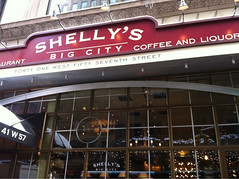
Discovered that my daughter, Shelly, had started her own restaurant!

Went into FAO Schwartz and found this darling Noah's Ark for only $2,300!
Found the Apple Store. (You know I had to go to the New York Apple Store!) It was fantastic! The glass entryway led to the underground store that was open to the sky. There was a clear elevator that took you down into the store inself. Of course, the store was HUGE! Way bigger than the one in Tulsa. I didn't buy anything, but it was fun to be there.
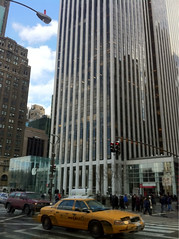

Glass enclosure - super Cool!
Next we crossed over to Central Park. The first thing I saw was the horses along the street. How pretty they were with their carriages.

Horses
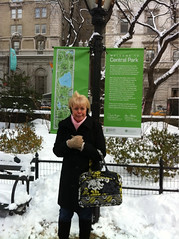
It was extremely cold today. This is me experience Central Park in 0 degree weather!
But we pressed on and walked to the skating rink in the park.

My cousin, Debbie, pointing the way.
What a breathtaking view! The sun was shining; the snow was glistening; and the brilliant colors of the kids jackets racing around the pond completed a picture I will long remember.

Skating in Central Park with view of the skyline in the background.
That was all we could take for this tour. We headed back to the hotel for me to get ready for the conference.

Found the Statue of Liberty. OK, it wasn't the real one, but it was close enough!

Discovered that my daughter, Shelly, had started her own restaurant!

Went into FAO Schwartz and found this darling Noah's Ark for only $2,300!
Found the Apple Store. (You know I had to go to the New York Apple Store!) It was fantastic! The glass entryway led to the underground store that was open to the sky. There was a clear elevator that took you down into the store inself. Of course, the store was HUGE! Way bigger than the one in Tulsa. I didn't buy anything, but it was fun to be there.


Glass enclosure - super Cool!
Next we crossed over to Central Park. The first thing I saw was the horses along the street. How pretty they were with their carriages.

Horses

It was extremely cold today. This is me experience Central Park in 0 degree weather!
But we pressed on and walked to the skating rink in the park.

My cousin, Debbie, pointing the way.
What a breathtaking view! The sun was shining; the snow was glistening; and the brilliant colors of the kids jackets racing around the pond completed a picture I will long remember.

Skating in Central Park with view of the skyline in the background.
That was all we could take for this tour. We headed back to the hotel for me to get ready for the conference.
Saturday, January 22, 2011
Day 3 NYC - Getting to NYC
What fun I had today, so far. Right now, I am waiting for registration to the conference to open. Debbie has gone to a museum down the street. We'll meet up again at dinner time.
The day started with snow! My wonderful cousin-in-law, Jim, cleared away the "blizzard" while we finished packing. (It would be a blizzard in Oklahoma. They had 4-6 inches. But by 9:00 the roads were completely cleared. Amazing!
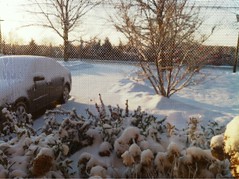
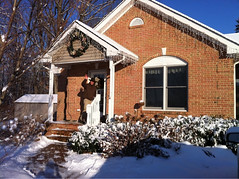
Jim dropped us off at Hamilton Station where we got on the train. We were able to take an earlier train than we had planned. Although the train stopped at every station, we got into NYC before our original train would have arrived. So we were ahead of schedule.
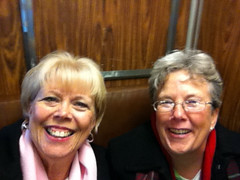

Then we got on a subway! I've never ridden a subway, so that was a fun adventure. The subway took us almost directly in front of our hotel.
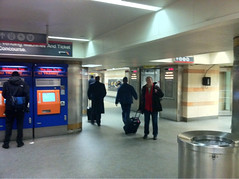
Debbie leads the way!
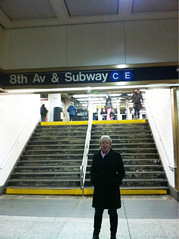
Ready to embark!

Eeeeek! It's moving!
My first view of NYC from the subway:

Our hotel:

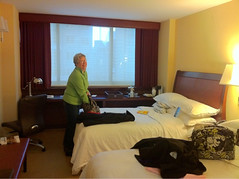
After we settled our stuff in our room, we took off for some adventures in the big city before my conference started. First, we went across the street to Lindy's for some cheesecake! We shared and I only ate 3 bites. I also had 1/2 steak burger.
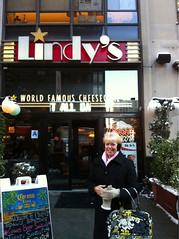
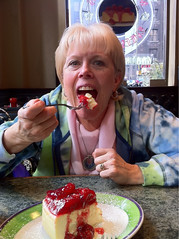
After lunch, we took a tour of our area around the hotel. You can read about that on my next blog post.
The day started with snow! My wonderful cousin-in-law, Jim, cleared away the "blizzard" while we finished packing. (It would be a blizzard in Oklahoma. They had 4-6 inches. But by 9:00 the roads were completely cleared. Amazing!


Jim dropped us off at Hamilton Station where we got on the train. We were able to take an earlier train than we had planned. Although the train stopped at every station, we got into NYC before our original train would have arrived. So we were ahead of schedule.


Then we got on a subway! I've never ridden a subway, so that was a fun adventure. The subway took us almost directly in front of our hotel.

Debbie leads the way!

Ready to embark!

Eeeeek! It's moving!
My first view of NYC from the subway:

Our hotel:


After we settled our stuff in our room, we took off for some adventures in the big city before my conference started. First, we went across the street to Lindy's for some cheesecake! We shared and I only ate 3 bites. I also had 1/2 steak burger.


After lunch, we took a tour of our area around the hotel. You can read about that on my next blog post.
Friday, January 21, 2011
Day 3 NYC Trip
TOday is the day! It snowed 4-6 inches here in New Jersey, but my cousin assures me this is nothing. We can see I-95 from her LR window and sure enough, they are roaring down the highway. A big difference from Oklahoma!

We are heading to Hamilton Station and taking the train up to New York City this morning. Then we;re going to walk to our hotel (in 0 degree chill factor) and check in. After that, we are going to walk to Central Park to see the horses (will they be out in this weather?) and the ice skating.
Then it's lunch somewhere and head back to hotel to the start of the conference at 3:00 pm. Exciting!

We are heading to Hamilton Station and taking the train up to New York City this morning. Then we;re going to walk to our hotel (in 0 degree chill factor) and check in. After that, we are going to walk to Central Park to see the horses (will they be out in this weather?) and the ice skating.
Then it's lunch somewhere and head back to hotel to the start of the conference at 3:00 pm. Exciting!
Thursday, January 20, 2011
Day 2 - NYC
Ahhh. I'm sitting here on the sofa in my cousin's house outside Trenton, NJ. waiting for her to get up. After all, it's 6:00!
I slept from 8 last night to 5 this morning! I guess I was tired. Now I'm having a cup of hot cocoa waiting AGAIN! How can people sleep so late?
Since we should have been at my brother's house in Lewes at this point, we have a change in schedule. Not sure what we are going to do today, but knowing my cousin, it will be fun! Last night she took me to an absolutely fabulous Italian restaurant. They had rolls that looked like mini croissants, but were italian bread. It was served with a delicious dunking sauce. Then I had some kind of chicken that was Italiazed with peppers, onion, carrots, zucchini. Then a side dish of EAst Coast pasta - penne in a bowl with parmesan cheese. YUMM! I don't think I did too bad points wise. I ate only 1/2 of chicken, the vegetables, a small portion of the pasta. The only thing I did bad was have 2-1/2 of the breads, but they were small.
It appears I got out of OK and St. Louis just in time. They are having a snow storm. It's supposed to snow here on Thursday, which could affect my getting into NYC for the writer's conference. Praying for only as much as NY can handle. They can handle way more than Tulsa!
Have a good day!
I slept from 8 last night to 5 this morning! I guess I was tired. Now I'm having a cup of hot cocoa waiting AGAIN! How can people sleep so late?
Since we should have been at my brother's house in Lewes at this point, we have a change in schedule. Not sure what we are going to do today, but knowing my cousin, it will be fun! Last night she took me to an absolutely fabulous Italian restaurant. They had rolls that looked like mini croissants, but were italian bread. It was served with a delicious dunking sauce. Then I had some kind of chicken that was Italiazed with peppers, onion, carrots, zucchini. Then a side dish of EAst Coast pasta - penne in a bowl with parmesan cheese. YUMM! I don't think I did too bad points wise. I ate only 1/2 of chicken, the vegetables, a small portion of the pasta. The only thing I did bad was have 2-1/2 of the breads, but they were small.
It appears I got out of OK and St. Louis just in time. They are having a snow storm. It's supposed to snow here on Thursday, which could affect my getting into NYC for the writer's conference. Praying for only as much as NY can handle. They can handle way more than Tulsa!
Have a good day!
Wednesday, January 19, 2011
Take-off Part 2
It's 10:37 am and I'm not out of Tulsa yet. (I was supposed to leave at 7:15). Plane 2 is having heart trouble. Needs a transplant. They are "working on it" and assure me that it will leave "soon".
Meanwhile, I have a seat to myself, which is nice. I'm praying this plane is a keeper and gets me out of St Louis. Before the snow hits.
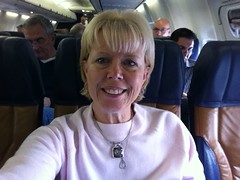
Have a great day!
Meanwhile, I have a seat to myself, which is nice. I'm praying this plane is a keeper and gets me out of St Louis. Before the snow hits.

Have a great day!
First Day - Takeoff Part I
What a day so far! I was worried about getting stuck in the airport because of ice or snow. No so! Here's my day. First, I got out the door - no problem!

Then, I got through security.
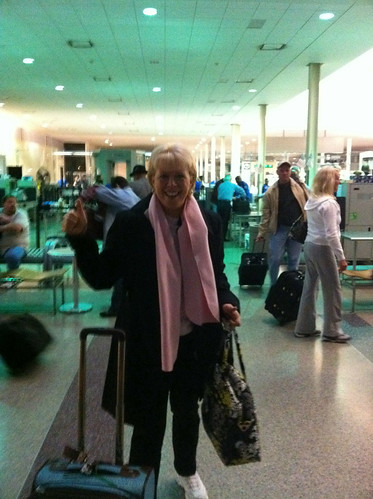
No problem!
Then, I got on the plane. Got my drink, seatbelt on, iPad out for some fun time. Got a great window seat with easy exit. Then! The plane broke! They called maintenance - no can fix.
We all got unloaded and told to wait while they find us a new plane. I waited and waited and waited.

Apparently, I was the only one flying into Philadelphia. Last one called. They gave me a choice of 7:00 or 11:00 tonight. I picked 7:00. Then the clerk next to us said, "Hey what about that plane that's flying directly to Philadelphi?"
So, I'm waiting for the 10:30 flight to Philadelphia; nonstop. Will get me in at 4:00. Too late for my visit with my brother, but at least I'll get to Trenton and NYC.
Now, It's time for breakfast: banana, OJ, and a piece of a breakfast sandwich - airport style.

Then, I got through security.

No problem!
Then, I got on the plane. Got my drink, seatbelt on, iPad out for some fun time. Got a great window seat with easy exit. Then! The plane broke! They called maintenance - no can fix.
We all got unloaded and told to wait while they find us a new plane. I waited and waited and waited.

Apparently, I was the only one flying into Philadelphia. Last one called. They gave me a choice of 7:00 or 11:00 tonight. I picked 7:00. Then the clerk next to us said, "Hey what about that plane that's flying directly to Philadelphi?"
So, I'm waiting for the 10:30 flight to Philadelphia; nonstop. Will get me in at 4:00. Too late for my visit with my brother, but at least I'll get to Trenton and NYC.
Now, It's time for breakfast: banana, OJ, and a piece of a breakfast sandwich - airport style.
Tuesday, January 18, 2011
Felix has it under control!
Felix is helping me pack - it's a good thing because I am overwhelmed!
I've got all this stuff and can't decide what to take on the plane and what to put in cargo. Then there's the problem of my makeup. I can't fit it all in the plastic baggie! (That's what happens when you get my age. It takes more to keep the wrinkles hidden!)
So, it's back to the drawing board. When is that plane taking off?
Sunday, January 16, 2011
Critique Group
This month, I've been working on the text for a picture book about Caroline Harrison and her ferrets. The transition from writing nonfiction to fiction has been extremely difficult for; but I think I found a way for me to do it. I switched to rhyme instead of prose.
By writing in rhyme, I find myself being more creative. When I try to write fiction in prose, I tend to fall back on my nonfiction writing and start teaching! Not exciting at all!
My critique group is also helping me make this transition. I have the best group of ladies you could ask for. We get together once a month for munchies and critiques of each other's work. This has been extremely helpful and encouraging for me. Helpful because after working on a project awhile, we can't always see our own problems; encouraging because we're all on this journey together.
If you don't have a critique group, I suggest you find one or start one. A group of four is an ideal number. We usually get done in about 2 hours.
By writing in rhyme, I find myself being more creative. When I try to write fiction in prose, I tend to fall back on my nonfiction writing and start teaching! Not exciting at all!
My critique group is also helping me make this transition. I have the best group of ladies you could ask for. We get together once a month for munchies and critiques of each other's work. This has been extremely helpful and encouraging for me. Helpful because after working on a project awhile, we can't always see our own problems; encouraging because we're all on this journey together.
If you don't have a critique group, I suggest you find one or start one. A group of four is an ideal number. We usually get done in about 2 hours.
Preparation for NYC
Today, I bought my quart zip bag for my carry-on bag. I can't believe I have to get all my shampoo, rinse, makeup, etc. into this tiny bag? Yes, I know. I could check them, but what if they lose my luggage? I sure wouldn't want to show up in New York with no makeup on. I want to make a good impression, not scare them away!
Next, they want me to measure and weigh my luggage. Gee, that sounds like Weight Watchers! I get enough of that every week at weigh in.
Next, I have to remember all my electronics: iPhone, iPad, chargers, keyboards, earphones, cables. I'm wondering how I'm going to use my earphones, when I'll have ear planes in my ear for air pressure. Hmmmm, I'll have to figure that one out, later.
As you can see, I don't fly very often. My girlfriends, Linda, Linda, Linda, (yes, I know a lot of Lindas!) Melanie, and Mary have been coaching me through. I think they will be glad when I get off. Then it will be my cousin, Debbie's turn to deal with the Country Girl in NYC!
Next, they want me to measure and weigh my luggage. Gee, that sounds like Weight Watchers! I get enough of that every week at weigh in.
Next, I have to remember all my electronics: iPhone, iPad, chargers, keyboards, earphones, cables. I'm wondering how I'm going to use my earphones, when I'll have ear planes in my ear for air pressure. Hmmmm, I'll have to figure that one out, later.
As you can see, I don't fly very often. My girlfriends, Linda, Linda, Linda, (yes, I know a lot of Lindas!) Melanie, and Mary have been coaching me through. I think they will be glad when I get off. Then it will be my cousin, Debbie's turn to deal with the Country Girl in NYC!
Friday, January 7, 2011
NYC - Here I Come!
I'll be heading to New York City later this month for a Writer's Conference . I've never been to New York to visit, so I'm really excited!
Not only will I get to enjoy the conference, but my cousin, Debbie, will be my tour guide. She's going to help me see the sites. She the best tour guide in the world and should go into business. Last summer, she took me to all kinds of fun place in New Jersey.
I'll blog about my adventures in the city. In the meantime, I'm praying for NO snow or ice so I can travel. I can take the cold, but not the ice!
Not only will I get to enjoy the conference, but my cousin, Debbie, will be my tour guide. She's going to help me see the sites. She the best tour guide in the world and should go into business. Last summer, she took me to all kinds of fun place in New Jersey.
I'll blog about my adventures in the city. In the meantime, I'm praying for NO snow or ice so I can travel. I can take the cold, but not the ice!
Subscribe to:
Posts (Atom)




